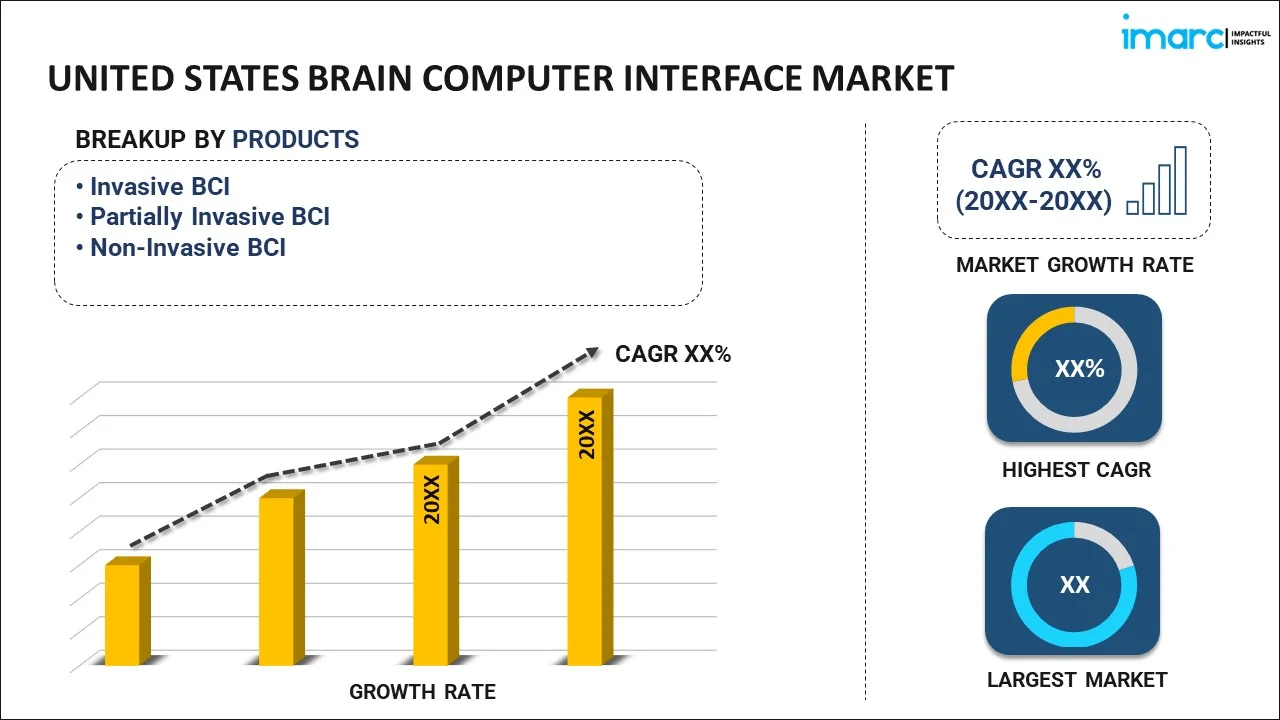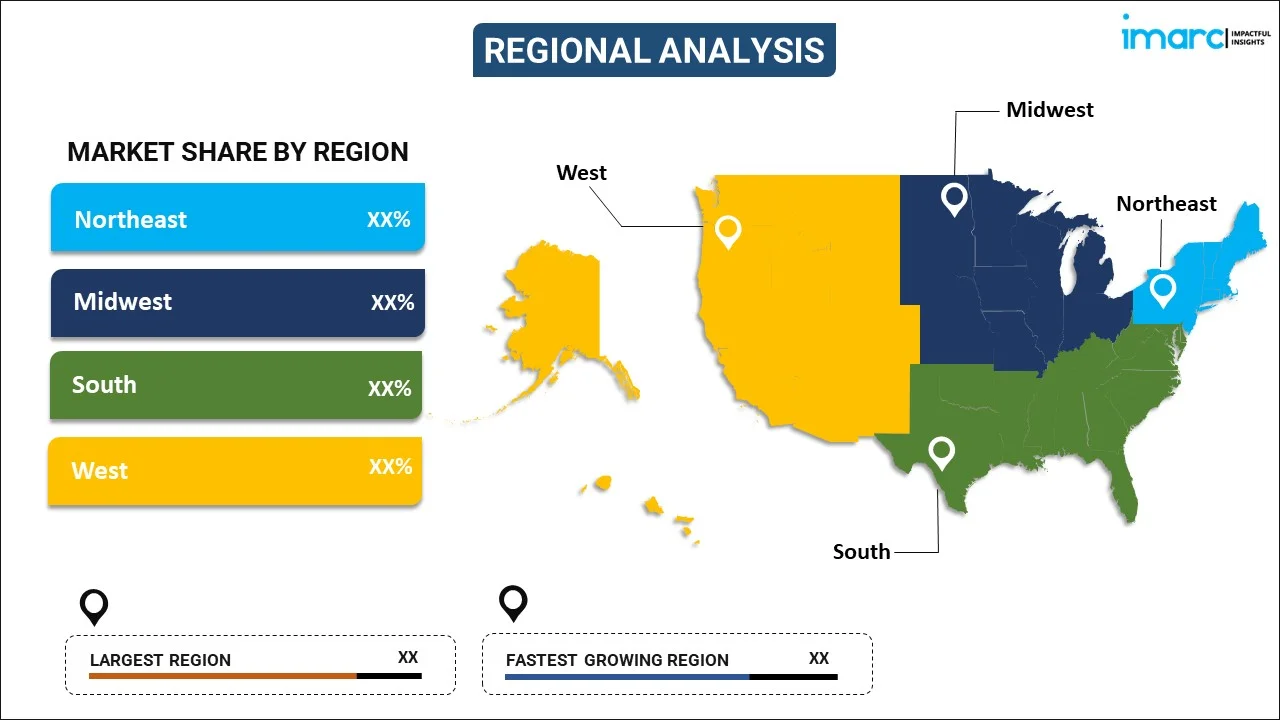
United States Brain Computer Interface Market Report by Product (Invasive BCI, Partially Invasive BCI, Non-Invasive BCI), Application (Healthcare, Smart Home Control, Communication and Control, Entertainment and Gaming), and Region 2024-2032
Market Overview:
United States brain computer interface market size is projected to exhibit a growth rate (CAGR) of 16.60% during 2024-2032. Continuous technological advancements in nanotechnology, bio-sensing, bio-signal processing, and neuro-imaging techniques are primarily driving the market growth across the country.
|
Report Attribute
|
Key Statistics
|
|---|---|
|
Base Year
|
2023 |
|
Forecast Years
|
2024-2032 |
|
Historical Years
|
2018-2023
|
| Market Growth Rate (2024-2032) | 16.60% |
A brain-computer interface (BCI) is a system designed to acquire, analyze, and interpret brain signals, translating them into commands through an artificial output device. This technology plays a crucial role in substituting, restoring, enhancing, supplementing, and improving the functions of the central nervous system (CNS). A brain-computer interface is employed to replace or restore essential functionalities in individuals affected by neuromuscular disorders such as cerebral palsy, amyotrophic lateral sclerosis, or spinal cord injury. Moreover, it proves valuable in rehabilitation efforts following a stroke or other similar disorders. With its extensive application in communication and control for patients experiencing severe paralysis or locked-in syndrome (LIS), the demand for a brain-computer interface is on the rise.
United States Brain Computer Interface Market Trends:
The United States brain computer interface market is undergoing significant advancements, driven by a convergence of drivers and emerging trends that highlight the expanding applications and technological breakthroughs in this transformative field. Additionally, the integration of artificial intelligence and machine learning into brain computer interface systems is revolutionizing their analytical and interpretative capacities. Besides this, the increasing prevalence of neurological disorders is another key driver propelling the market growth across the country. Moreover, as the incidence of conditions like amyotrophic lateral sclerosis (ALS) and spinal cord injuries rises, there is a growing demand for brain computer interface solutions that can restore or augment impaired neural functions. Apart from this, a notable trend in the United States brain computer interface market is its expanding role in healthcare and rehabilitation. Furthermore, government initiatives and increased research funding are providing a conducive environment for the growth of the market across the country. Collaborations between research institutions, technology companies, and healthcare providers are fostering innovation and driving the adoption of brain computer interface solutions across various sectors. Besides this, technological advancements, increased healthcare applications, and the growing focus on neurorehabilitation are anticipated to fuel the market growth across the country over the forecasted period.
United States Brain Computer Interface Market Segmentation:
IMARC Group provides an analysis of the key trends in each segment of the market, along with forecasts at the country level for 2024-2032. Our report has categorized the market based on product and application.
Product Insights:

- Invasive BCI
- Partially Invasive BCI
- Non-Invasive BCI
The report has provided a detailed breakup and analysis of the market based on the product. This includes invasive BCI, partially invasive BCI, and non-invasive BCI.
Application Insights:
- Healthcare
- Smart Home Control
- Communication and Control
- Entertainment and Gaming
A detailed breakup and analysis of the market based on the application have also been provided in the report. This includes healthcare, smart home control, communication and control, and entertainment and gaming.
Regional Insights:

- Northeast
- Midwest
- South
- West
The report has also provided a comprehensive analysis of all the major regional markets, which include Northeast, Midwest, South, and West.
Competitive Landscape:
The market research report has also provided a comprehensive analysis of the competitive landscape in the market. Competitive analysis such as market structure, key player positioning, top winning strategies, competitive dashboard, and company evaluation quadrant has been covered in the report. Also, detailed profiles of all major companies have been provided.
United States Brain Computer Interface Market Report Coverage:
| Report Features | Details |
|---|---|
| Base Year of the Analysis | 2023 |
| Historical Period | 2018-2023 |
| Forecast Period | 2024-2032 |
| Units | US$ Million |
| Scope of the Report | Exploration of Historical Trends and Market Outlook, Industry Catalysts and Challenges, Segment-Wise Historical and Future Market Assessment:
|
| Products Covered | Invasive BCI, Partially Invasive BCI, Non-Invasive BCI |
| Applications Covered | Healthcare, Smart Home Control, Communication and Control, Entertainment and Gaming |
| Regions Covered | Northeast, Midwest, South, West |
| Customization Scope | 10% Free Customization |
| Report Price and Purchase Option | Single User License: US$ 3699 Five User License: US$ 4699 Corporate License: US$ 5699 |
| Post-Sale Analyst Support | 10-12 Weeks |
| Delivery Format | PDF and Excel through Email (We can also provide the editable version of the report in PPT/Word format on special request) |
Key Questions Answered in This Report:
- How has the United States brain computer interface market performed so far and how will it perform in the coming years?
- What has been the impact of COVID-19 on the United States brain computer interface market?
- What is the breakup of the United States brain computer interface market on the basis of product?
- What is the breakup of the United States brain computer interface market on the basis of application?
- What are the various stages in the value chain of the United States brain computer interface market?
- What are the key driving factors and challenges in the United States brain computer interface?
- What is the structure of the United States brain computer interface market and who are the key players?
- What is the degree of competition in the United States brain computer interface market?
Key Benefits for Stakeholders:
- IMARC’s industry report offers a comprehensive quantitative analysis of various market segments, historical and current market trends, market forecasts, and dynamics of the United States brain computer interface market from 2018-2032.
- The research report provides the latest information on the market drivers, challenges, and opportunities in the United States brain computer interface market.
- Porter's five forces analysis assist stakeholders in assessing the impact of new entrants, competitive rivalry, supplier power, buyer power, and the threat of substitution. It helps stakeholders to analyze the level of competition within the United States brain computer interface industry and its attractiveness.
- Competitive landscape allows stakeholders to understand their competitive environment and provides an insight into the current positions of key players in the market.
Need more help?
- Speak to our experienced analysts for insights on the current market scenarios.
- Include additional segments and countries to customize the report as per your requirement.
- Gain an unparalleled competitive advantage in your domain by understanding how to utilize the report and positively impacting your operations and revenue.
- For further assistance, please connect with our analysts.
 Inquire Before Buying
Inquire Before Buying
 Speak to an Analyst
Speak to an Analyst
 Request Brochure
Request Brochure
 Request Customization
Request Customization




.webp)




.webp)












